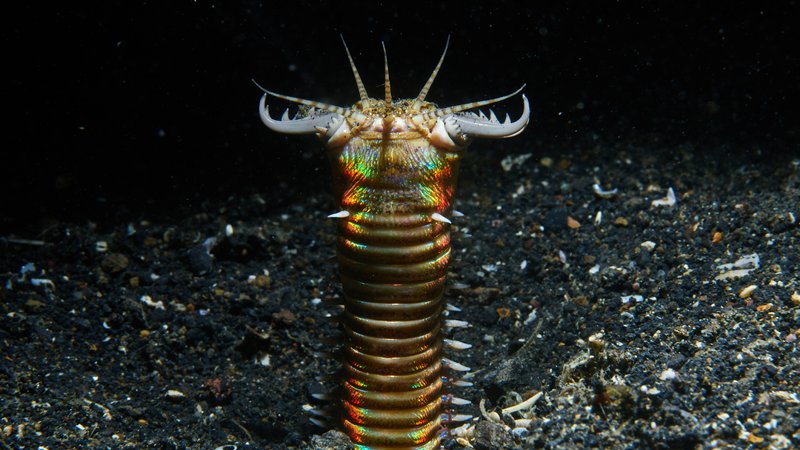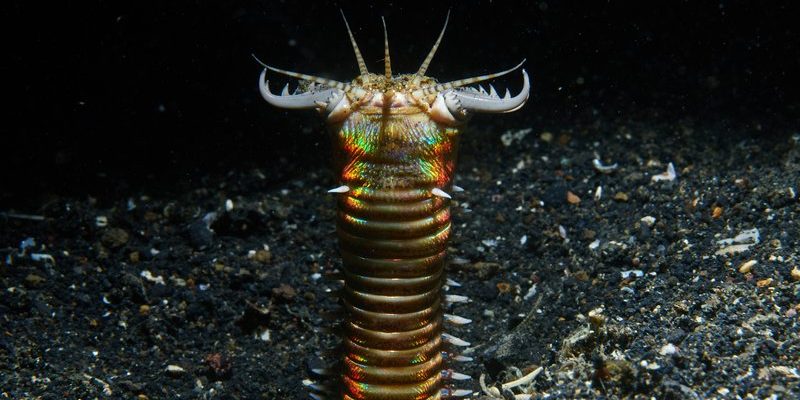
Bobbit worms may look like simple, colorful tubes at first glance, but their hunting prowess is anything but ordinary. From their unique jaw mechanics to the sheer speed of their strikes, these worms offer a deep dive into the world of underwater predation. It’s a bit like watching an action movie unfold in slow motion, filled with intense moments that leave you hanging on the edge of your seat. Let’s explore the incredible ways bobbit worms hunt, starting with their impressive **strike speed** and how their jaw mechanics work.
The Anatomy of a Bobbit Worm
To truly understand how bobbit worms hunt, we first need to take a look at their anatomy. These creatures can grow anywhere from around 3 to 10 feet long, depending on the species, and their bodies are made up of multiple segments. Each segment can contain tiny appendages that provide both movement and sensation, allowing them to navigate their habitat with ease.
One of the most striking features of the bobbit worm is its **jaws**. They possess impressive, serrated jaws that can snap shut at astonishing speeds. Imagine a jaw that opens wide, ready to snag unsuspecting fish or crustaceans! When hunting, this worm can extend its jaw out of its body, camouflaging itself among the sediment and using those sharp teeth to grip onto its prey securely.
Bobbit worms generally live buried in sandy or muddy substrates, making them expert ambush predators. They don’t just haphazardly strike at anything; they rely on their keen senses to detect movement and vibrations in the water, which signal the presence of potential meals nearby.
The Bobbit Worm’s Striking Technique
Now, let’s get into the fascinating part: the actual strike. Did you know that bobbit worms can strike in a split second? Their **strike speed** is something to marvel at. When a bobbit worm senses a potential meal, it can launch its jaw with incredible force. Studies suggest that they can strike in less than a millisecond, making them one of the fastest predators in their ecosystem.
Here’s how it works: once the worm detects movement, it engages its jaw muscles to launch its mouth outward, grabbing the prey and pulling it back into its burrow. This powerful movement is not just quick; it’s also precise. Imagine a slingshot—the faster you pull it back, the quicker the projectile flies. Bobbit worms have honed this technique to perfection, making their hunting style highly efficient.
Because their jaws are made of chitin, a tough organic material, they’re built to withstand the stress of capturing slippery fish and crustaceans. The mechanics of their strike involve a combination of muscle contractions and hydraulic pressure, allowing for that sudden, forceful snap. Isn’t that remarkable?
The Role of Camouflage in Hunting
Aside from their striking abilities, camouflage plays an essential role in how bobbit worms hunt. They spend most of their life hidden beneath the sand, their colorful bodies blending in with their surroundings. This natural camouflage helps them avoid detection from potential predators, as well as from those unsuspecting fish looking for a meal.
When bobbit worms are lying in wait, their bodies often resemble bits of debris or pieces of seaweed, which makes it hard for prey to spot them. They can remain motionless for long periods, which is key to their ambush strategy. It’s kind of like a cat waiting silently before pouncing on its toy mouse—patience is crucial!
This stealthy approach keeps them safe while also positioning them perfectly to strike. When their victim is close enough, they spring into action, taking advantage of that moment of surprise. Honestly, it’s a perfect example of how nature combines patience and precision in hunting strategies.
Understanding Their Prey
So, what do bobbit worms actually eat? They mostly feed on fish, crustaceans, and various marine invertebrates. Their diet is quite diverse, but the key is to choose prey that’s small enough to capture but substantial enough to provide a nutritious meal.
Bobbit worms are opportunistic feeders. This means they take advantage of whatever comes their way. When a fish swims too close, **suddenly**, the bobbit worm strikes. They rely on their sharp sense of vibration to detect potential meals. You might think of them as the “hunters” in their underwater realm, using a mix of stealth, speed, and cunning to secure their next meal.
Interestingly, bobbit worms exhibit a behavior known as “benthic foraging,” which involves them adjusting their hunting strategies based on the availability of different prey. If fish are scarce, they may target smaller invertebrates instead. This adaptability is crucial for their survival in dynamic marine environments.
The Ecological Impact of Bobbit Worms
Bobbit worms may be fierce predators, but they also play a vital role in their ecosystem. As they hunt, they help regulate the populations of various marine species. By keeping certain fish and invertebrate populations in check, bobbit worms contribute to the overall health of their habitat.
However, their predation also has a ripple effect on the food web. For example, when fish populations decrease due to bobbit worm hunting, this can lead to changes in the availability of food for larger predators. Essentially, these worms help maintain balance within their underwater environment.
Additionally, their burrowing activities help aerate the seabed and cycle nutrients back into the ecosystem, promoting overall biodiversity. So, while they may seem ruthless in their approach, bobbit worms are essential components of their marine habitats, showcasing how even the most fearsome creatures can be crucial to ecological balance.
In conclusion, bobbit worms are fascinating creatures with unique hunting techniques that showcase the ingenuity of nature. From their incredible strike speed to their lethal jaw mechanics, these worms are masters of ambush predation. Their ability to camouflage themselves while waiting patiently for the right moment to strike is nothing short of impressive.
As we explore the depths of the ocean and uncover its mysteries, bobbit worms remind us that even the smallest creatures can possess the most extraordinary skills. They play a significant role in their ecosystems while exhibiting an intriguing blend of patience, precision, and predatory prowess. So, the next time you think about the wonders of the ocean, remember the bobbit worm and its ninja-like hunting style—it’s a reminder of just how amazing nature can be!

